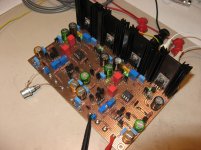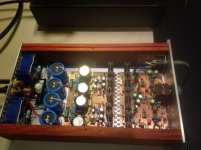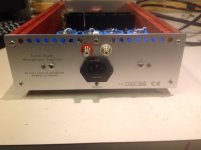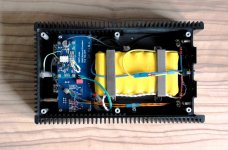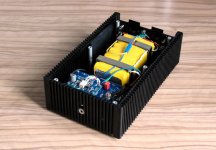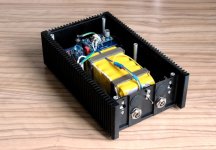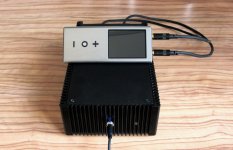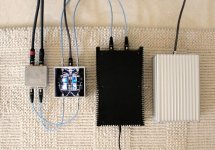Earlier in the JLH Headphone thread, we mentioned that we intended to benchmark various headphone amplifier designs of ours against some legendary circuits.
We already discussed the Pioneer Super Linear circuit and the JLH 1985 headphone amplifier elsewhere.
Another one on our list is Erno Borbely's EB602/201, which is actually the FET version of his Hybrid headphone amp.
It is a circuit that has been copied and adapted so many times with new names given.
This article is thus meant to be a tribute to Erno Borbely’s original design.
We were lucky enough to have Mr. Borbely himself reviewed and approved the publication of the article.
Patrick
PS Forum restricts PDF files size and thus it has to be broken into 4 parts.
.
We already discussed the Pioneer Super Linear circuit and the JLH 1985 headphone amplifier elsewhere.
Another one on our list is Erno Borbely's EB602/201, which is actually the FET version of his Hybrid headphone amp.
It is a circuit that has been copied and adapted so many times with new names given.
This article is thus meant to be a tribute to Erno Borbely’s original design.
We were lucky enough to have Mr. Borbely himself reviewed and approved the publication of the article.
Patrick
PS Forum restricts PDF files size and thus it has to be broken into 4 parts.
.
Attachments
All the links in the references :
1. A Battery-Powered Class A Headphone Amp
A Battery-Powered Class A Headphone Amp | audioXpress
2. 이복열님(zerosoft) - [자작] Borbely 헤드폰 앰프
3. ludus luminosus
4. 6moons audio reviews: Aural Audition
5. 신정섭님(sijosae) - [습작소개] 묻지마 Borbely 완성
6. http://www.headphoneamp.co.kr/diy_sijosae/18658
7. Salas DCG3 preamp (line & headphone)
8. Tubecad : Email from Erno Borbely
https://www.tubecad.com/2004/blog0001.htm
9. Erno Borbely Annals
https://linearaudio.nl/sites/linearaudio.net/files/BorbelyAnnalsMMM508.pdf
10. https://www.passdiy.com/pdf/diyopamp.pdf
11. Borbely EB1198/116 audioXpress May 2002
http://citeseerx.ist.psu.edu/viewdoc/download?doi=10.1.1.211.7855&rep=rep1&type=pdf
12. http://www.diyhifi.org/forums/viewtopic.php?f=5&t=2144&start=30
13. Audio Current Regulator Tests for High Performance
http://waltjung.org/PDFs/Sources_101_P1.pdf
14. Groner Comments on “Audio Power Amplifier Design Handbook” by Douglas Self, Feb. 2011.
Patrick
1. A Battery-Powered Class A Headphone Amp
A Battery-Powered Class A Headphone Amp | audioXpress
2. 이복열님(zerosoft) - [자작] Borbely 헤드폰 앰프
3. ludus luminosus
4. 6moons audio reviews: Aural Audition
5. 신정섭님(sijosae) - [습작소개] 묻지마 Borbely 완성
6. http://www.headphoneamp.co.kr/diy_sijosae/18658
7. Salas DCG3 preamp (line & headphone)
8. Tubecad : Email from Erno Borbely
https://www.tubecad.com/2004/blog0001.htm
9. Erno Borbely Annals
https://linearaudio.nl/sites/linearaudio.net/files/BorbelyAnnalsMMM508.pdf
10. https://www.passdiy.com/pdf/diyopamp.pdf
11. Borbely EB1198/116 audioXpress May 2002
http://citeseerx.ist.psu.edu/viewdoc/download?doi=10.1.1.211.7855&rep=rep1&type=pdf
12. http://www.diyhifi.org/forums/viewtopic.php?f=5&t=2144&start=30
13. Audio Current Regulator Tests for High Performance
http://waltjung.org/PDFs/Sources_101_P1.pdf
14. Groner Comments on “Audio Power Amplifier Design Handbook” by Douglas Self, Feb. 2011.
Patrick
Independent Audition
As you can see the project has been finished for a while.
So we had the chance to have it gone through thorough auditioning in Germany.
"Powered by normal regulators, the initial impression was that the EB602 is very capable and transforms everything coming from the source into music at a very high level,
a very good amplifier that sounds very dynamic with very good control over the entire spectrum.
Detail, dynamics, space... it's all there. But presentation in general is a touch harder when compared to the DAO SE. "
But we discovered a comment in Ref.1 that reads :
"When I used an AC regulated supply (Linear Tech. LT317), the sound became harder, with more edge, and lost some of the smoothness in the high frequencies.
Low end was always very tight and extended with both supplies.
I must conclude that the battery PSU makes an audible difference and was well worth the time and cost."
So we repeated the audition again using 40x AA alkaline batteries as power supply.
“Indeed the Borbely didn't have the slightly hard side that I heard with the lab supply... in fact it sounded pretty convincing! “
We also had someone in Finland who happens to also own a vertical-MOSFET variant (let’s call that SDXX) of the Borbely, so that we can do direct comparisons with the original.
Here are the remarks from the auditioner :
“I have had now three separate listening sessions with the Borbely vs. SDXX and I think I have come to some conclusions.
Bass:
Borbely goes a little bit deeper, but the SDXX has a little tighter and better bass separation.
Mid region/vocals:
This is where the Borbely really shines. Especially female vocals are very good and presence is exemplary. Overall the Borbely delivers more feeling to the music.
Highs:
No big differences: There was a couple of occasions where the SDXX seemed to be a little too bright which I didn’t notice with Borbely.
Soundstage:
This where the SDXX is better than Borbely. SDXX has a tiny bit wider presentation and there’s more depth too - a bit like 3D soundstage.
My test setup:
• Raspberry Pi with Moode Audio player software => Ian Canada's isolator board => Allo Kali reclocker board => I2S output
• I2S input to DDDAC DA-converter (a single Tent shunt board version)
• All music files were FLAC 16bit/44.1kHz ripped from original CDs with dB Power Amp software.
• The volume levels between Borbely and SDXX were matched by feeding a 1 kHz test signal to the DAC and the voltage was measured from the headphone jack while my Audeze LCD-2 phones were connected.
• Volume control was the same for both headamps:
Arduino based LDR volume and source selection controller.
• My headphones used for the test were Audeze LCD-2.2 Fazor
Some more feedback a bit later :
“I just did some comparisons with my other pair of headphones, the Sennheiser HD800, and results were a bit different in favour of the Borbely.
The bass is still tighter and better controlled with SDXX but Borbely goes a bit deeper.
Vocals are again better with Borbely with better presence and overall smoothness.
Treble section was also easier to compare now since HD800 is more brighter headphone than Audeze, and yes, the Borbely is a winner there also. There’s just more finesse and less roughness.
Now the soundstage... For some reason I couldn’t tell the two apart!
Maybe the Senns are just that much different load to the amps with their 300ohm resistance (Audeze 70ohm), that it shows somehow.
Also the Senns do have a wider soundstage by nature than my Audeze.
Perhaps the soundstage of Audeze gains from more power, so it kind of ”opens up” with more juice?
Also I have to say that the Borbely is more easy to listen and doesn’t cause listening fatique as much as SDXX.
This was something that was present with both headphones.
To sum it all up, I think the Borbely is a better match with HD800 than Audeze.
I have also noticed that the HD800s work better with tube amps.
The Borbely is a little more ”tubey” than regular transistor amps...”
Patrick
As you can see the project has been finished for a while.
So we had the chance to have it gone through thorough auditioning in Germany.
"Powered by normal regulators, the initial impression was that the EB602 is very capable and transforms everything coming from the source into music at a very high level,
a very good amplifier that sounds very dynamic with very good control over the entire spectrum.
Detail, dynamics, space... it's all there. But presentation in general is a touch harder when compared to the DAO SE. "
But we discovered a comment in Ref.1 that reads :
"When I used an AC regulated supply (Linear Tech. LT317), the sound became harder, with more edge, and lost some of the smoothness in the high frequencies.
Low end was always very tight and extended with both supplies.
I must conclude that the battery PSU makes an audible difference and was well worth the time and cost."
So we repeated the audition again using 40x AA alkaline batteries as power supply.
“Indeed the Borbely didn't have the slightly hard side that I heard with the lab supply... in fact it sounded pretty convincing! “
We also had someone in Finland who happens to also own a vertical-MOSFET variant (let’s call that SDXX) of the Borbely, so that we can do direct comparisons with the original.
Here are the remarks from the auditioner :
“I have had now three separate listening sessions with the Borbely vs. SDXX and I think I have come to some conclusions.
Bass:
Borbely goes a little bit deeper, but the SDXX has a little tighter and better bass separation.
Mid region/vocals:
This is where the Borbely really shines. Especially female vocals are very good and presence is exemplary. Overall the Borbely delivers more feeling to the music.
Highs:
No big differences: There was a couple of occasions where the SDXX seemed to be a little too bright which I didn’t notice with Borbely.
Soundstage:
This where the SDXX is better than Borbely. SDXX has a tiny bit wider presentation and there’s more depth too - a bit like 3D soundstage.
My test setup:
• Raspberry Pi with Moode Audio player software => Ian Canada's isolator board => Allo Kali reclocker board => I2S output
• I2S input to DDDAC DA-converter (a single Tent shunt board version)
• All music files were FLAC 16bit/44.1kHz ripped from original CDs with dB Power Amp software.
• The volume levels between Borbely and SDXX were matched by feeding a 1 kHz test signal to the DAC and the voltage was measured from the headphone jack while my Audeze LCD-2 phones were connected.
• Volume control was the same for both headamps:
Arduino based LDR volume and source selection controller.
• My headphones used for the test were Audeze LCD-2.2 Fazor
Some more feedback a bit later :
“I just did some comparisons with my other pair of headphones, the Sennheiser HD800, and results were a bit different in favour of the Borbely.
The bass is still tighter and better controlled with SDXX but Borbely goes a bit deeper.
Vocals are again better with Borbely with better presence and overall smoothness.
Treble section was also easier to compare now since HD800 is more brighter headphone than Audeze, and yes, the Borbely is a winner there also. There’s just more finesse and less roughness.
Now the soundstage... For some reason I couldn’t tell the two apart!
Maybe the Senns are just that much different load to the amps with their 300ohm resistance (Audeze 70ohm), that it shows somehow.
Also the Senns do have a wider soundstage by nature than my Audeze.
Perhaps the soundstage of Audeze gains from more power, so it kind of ”opens up” with more juice?
Also I have to say that the Borbely is more easy to listen and doesn’t cause listening fatique as much as SDXX.
This was something that was present with both headphones.
To sum it all up, I think the Borbely is a better match with HD800 than Audeze.
I have also noticed that the HD800s work better with tube amps.
The Borbely is a little more ”tubey” than regular transistor amps...”
Patrick
PMOS as Current Source
Apparently the PMOS of the Hitachi laterals are somewhat easier to find than the NMOS.
In theory there is no reason why the NMOS CCS cannot be replaced by a PMOS one.
And while doing that, one can modify the CCS into a modulated current source (MCS).
It is important to stress that while the MCS improves current driving capability and hence lowers distortion, it changes the distortion spectrum of the amplifier.
And this cannot be considered to have the same character of the original.
We have not built this, but decide to include it here for the interest of technical discussions.
Patrick
.
Apparently the PMOS of the Hitachi laterals are somewhat easier to find than the NMOS.
In theory there is no reason why the NMOS CCS cannot be replaced by a PMOS one.
And while doing that, one can modify the CCS into a modulated current source (MCS).
It is important to stress that while the MCS improves current driving capability and hence lowers distortion, it changes the distortion spectrum of the amplifier.
And this cannot be considered to have the same character of the original.
We have not built this, but decide to include it here for the interest of technical discussions.
Patrick
.
Attachments
I built the original Borbely Headphone amp a fiew years back, with an Audial look. Full dual mono design, with CRC pre-filtering and all discrete Borbely regulators. I made all the pcb by myself... Glad to see that EUVL had a close look at it.
Very nice map 😉
Very nice map 😉
Attachments
Indeed that's is the more advanced version, with K389/J109 front end (I used matched K170/J74 instead), and the CCS with two JFET and led for the final Mosfet. You mentioned some of these more complex solutions in your articles.
The reasons why I chose the single ended version were :
1) It is widely copied, but IMHO not properly.
2) It does not use the unobtainium 2SJ74 or 2SJ109, and most of the others are still available or have mordern day alternatives.
3) It has its unique SE sound signature, which is why I did not build the push-pull version of post #5.
The version in post #5 actually has very low distortion.
The front end LTP and current mirror already cancels a lot of second harmonics.
And the output push-pull adds to that.
But you cannot call it a Borbely EB602 anymore.
The one shown in post #6 is described here :
The All-FET Line Amp | audioXpress
Patrick
1) It is widely copied, but IMHO not properly.
2) It does not use the unobtainium 2SJ74 or 2SJ109, and most of the others are still available or have mordern day alternatives.
3) It has its unique SE sound signature, which is why I did not build the push-pull version of post #5.
The version in post #5 actually has very low distortion.
The front end LTP and current mirror already cancels a lot of second harmonics.
And the output push-pull adds to that.
But you cannot call it a Borbely EB602 anymore.
The one shown in post #6 is described here :
The All-FET Line Amp | audioXpress
Patrick
EB602-200 with Differential Inputs
A very good friend specially asked for a single ended headphone amplifier with balanced inputs.
The EB602-200 comes to mind as a natural choice, but the feedback resistor network is modified for that.
And since battery power is verified to give better results, it is powered with 20x AA size MiMH.
Also fitted is a buffered Danyuk crossfeed in balanced mode with volume control.
🙂
Patrick
.
A very good friend specially asked for a single ended headphone amplifier with balanced inputs.
The EB602-200 comes to mind as a natural choice, but the feedback resistor network is modified for that.
And since battery power is verified to give better results, it is powered with 20x AA size MiMH.
Also fitted is a buffered Danyuk crossfeed in balanced mode with volume control.
🙂
Patrick
.
Attachments
NiMH is easy because they can take trickle charge.
So I just use +/-15V in series with a diode and a 12R resistor.
When fully discharged, the batteries are at say 1.1V per call, so the difference is 3.3V, or 280mA.
Once it reaches 1.2V per cell, the current reduces to 200mA, or 1/10.C.
When fully charged, the cells are at 1.4V each, and the trickle current is 33mA, or 1/60.C.
After 10 hours or so, you can disconnect the charger altogether.
The modern low-leakage NiMH's will keep their charge for years.
😉
Patrick
So I just use +/-15V in series with a diode and a 12R resistor.
When fully discharged, the batteries are at say 1.1V per call, so the difference is 3.3V, or 280mA.
Once it reaches 1.2V per cell, the current reduces to 200mA, or 1/10.C.
When fully charged, the cells are at 1.4V each, and the trickle current is 33mA, or 1/60.C.
After 10 hours or so, you can disconnect the charger altogether.
The modern low-leakage NiMH's will keep their charge for years.
😉
Patrick
The case uses an industrial extrusion from ITEM :
item Catalog - Electronic-Box Profile 8 200x120 - 0.0.452.12
You can order them cut to length, quite handy. 🙂
Patrick
item Catalog - Electronic-Box Profile 8 200x120 - 0.0.452.12
You can order them cut to length, quite handy. 🙂
Patrick
NiMH is easy because they can take trickle charge.
So I just use +/-15V in series with a diode and a 12R resistor.
When fully discharged, the batteries are at say 1.1V per call, so the difference is 3.3V, or 280mA.
Once it reaches 1.2V per cell, the current reduces to 200mA, or 1/10.C.
When fully charged, the cells are at 1.4V each, and the trickle current is 33mA, or 1/60.C.
Thank you! Ok, trickle charging. That's very handy, no elaborate balanced charging and such. Still have a trickle charger somewhere in the drawers... 😉
One should charge at 1/10.C at the beginning when the cells are empty to save time.
Once they are full, one should reduce to 1/40.C or lower.
This can be done easily with the right voltage and series resistor value.
The latest low-leakage cells keep their charge easily over a year.
So there is no need for continuous trickle charge.
But the trickle charge allows you to leave the charger connected even when full.
It also helps to balance the cells automatically.
So you can just leave the charger on for a day after listening, and then listen for another 6~8 hours the next day.
And when not listening for a longer period, just take the charger off after a day.
Can't do that with Lithium.
😉
Patrick
Once they are full, one should reduce to 1/40.C or lower.
This can be done easily with the right voltage and series resistor value.
The latest low-leakage cells keep their charge easily over a year.
So there is no need for continuous trickle charge.
But the trickle charge allows you to leave the charger connected even when full.
It also helps to balance the cells automatically.
So you can just leave the charger on for a day after listening, and then listen for another 6~8 hours the next day.
And when not listening for a longer period, just take the charger off after a day.
Can't do that with Lithium.
😉
Patrick
From Left to Right :
Van der Veen MC 10 SUT
Other: MC10
Balanced version of Mr. Evil JFET Phono
All JFET open-loop RIAA pre-amp
(Post #31, 33)
The EB602 Differential
+/-20V PSU for the phono pre using 12x Annsmann 9V NiMH cells.
Separate supplies for L & R channels.
I think people totally underestimate how good the Mr. Evil phono is.
😉
Patrick
Van der Veen MC 10 SUT
Other: MC10
Balanced version of Mr. Evil JFET Phono
All JFET open-loop RIAA pre-amp
(Post #31, 33)
The EB602 Differential
+/-20V PSU for the phono pre using 12x Annsmann 9V NiMH cells.
Separate supplies for L & R channels.
I think people totally underestimate how good the Mr. Evil phono is.
😉
Patrick
- Home
- Amplifiers
- Headphone Systems
- The Borbely EB602-200 Revisited
